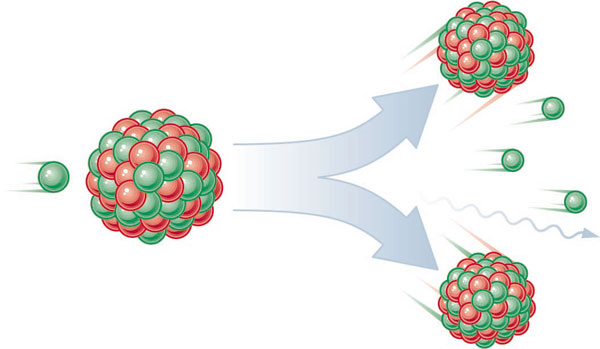Understanding Nuclear Power Plant Liability: A Guide To Ongoing Litigation

Table of Contents
The Price-Anderson Act and its Limitations
The Price-Anderson Act of 1957 is the cornerstone of nuclear power plant liability in the United States. Its primary purpose is to ensure adequate compensation to victims of nuclear incidents while limiting the financial exposure of the nuclear industry. This act defines the financial responsibility of nuclear power plant operators, establishing a system of both operator liability and government indemnification.
- Defines the financial responsibility of nuclear power plant operators: Operators are required to maintain a certain level of financial protection, typically through insurance or self-insurance.
- Sets a maximum liability limit for accidents: This limit, periodically adjusted, caps the total amount operators are responsible for paying out in damages.
- Government indemnification beyond the operator's liability limit: If damages exceed the operator's liability limit, the federal government steps in to cover the remaining costs.
- Recent amendments and their impact on liability: The Price-Anderson Act has undergone several amendments over the years, reflecting changes in technology, understanding of nuclear risks, and evolving legal interpretations. These amendments have, in some instances, modified liability limits and the allocation of responsibility between operators and the government.
However, the Price-Anderson Act is not without its limitations. Case studies, such as those involving minor incidents or protracted litigation, have tested the boundaries of its provisions. Ongoing debates focus on the adequacy of the current liability limits in the context of modern reactor designs (like advanced reactors) and the potential for more severe accidents. Some argue that the current limits are insufficient to cover the potential costs of a major catastrophe, while others maintain that the current system provides a sufficient balance between encouraging nuclear energy development and protecting the public.
Types of Litigation Related to Nuclear Power Plants
Litigation stemming from nuclear power plant operations can encompass a wide range of claims. High-profile accidents, such as Three Mile Island and Chernobyl, have demonstrated the devastating consequences of nuclear incidents and the subsequent complex legal battles.
- Nuclear accidents and their consequences: These accidents can lead to a multitude of legal claims, ranging from personal injury to environmental damage.
- Personal injury claims (radiation exposure, health complications): Individuals exposed to radiation may suffer long-term health consequences, leading to complex lawsuits demanding compensation for medical expenses, lost wages, and pain and suffering. Establishing direct causation between radiation exposure and health problems presents significant challenges.
- Property damage claims (land contamination, business interruption): Property owners near nuclear plants may experience property devaluation or even complete loss due to contamination. Businesses may also suffer financial losses due to interruptions in operations.
- Environmental damage claims (water contamination, ecological disruption): Nuclear accidents can cause severe environmental damage, requiring extensive cleanup efforts and compensation for ecological harm. Assessing and quantifying such damage is a complex process, often involving expert ecological assessments.
- Regulatory violations and associated penalties: Nuclear power plant operators are subject to stringent regulations. Violations can result in substantial fines and penalties, leading to additional litigation.
Proving causation and establishing liability in nuclear-related litigation presents unique challenges. The long latency periods between exposure and the manifestation of health problems, the complexities of radiation biology, and the difficulty in isolating specific causes all contribute to the intricacy of these cases. The role of expert witnesses – radiation biologists, epidemiologists, and engineers – is paramount in providing credible scientific evidence to support claims.
The Role of Insurance in Nuclear Power Plant Liability
Insurance plays a critical role in mitigating the financial risks associated with nuclear power plant operation. However, the unique nature of nuclear risks presents significant challenges for the insurance industry.
- Types of insurance policies relevant to nuclear power plants: This includes specialized nuclear liability insurance, as well as more general liability insurance policies covering other aspects of plant operation.
- Nuclear liability pools and their functions: Given the high potential for catastrophic losses, nuclear liability insurance is often provided through pools, where multiple insurers share the risk.
- Challenges in obtaining and maintaining adequate insurance coverage: The high risk associated with nuclear power plants makes it difficult and expensive to secure comprehensive insurance coverage.
- The impact of insurance settlements on overall liability: Insurance settlements can significantly reduce the financial burden on operators, but the availability and adequacy of insurance remain a critical concern.
The cost of nuclear insurance has steadily increased in recent years, reflecting the growing awareness of potential risks and the increased complexity of nuclear litigation. Reinsurance plays a vital role in mitigating catastrophic risk by allowing primary insurers to transfer a portion of their liability to other insurers, thereby spreading the risk across a broader market.
International Perspectives on Nuclear Liability
International cooperation is essential in addressing the complexities of transboundary nuclear accidents. Several international conventions aim to establish consistent legal frameworks for nuclear liability.
- The Vienna Convention on Civil Liability for Nuclear Damage: This convention establishes a framework for determining liability for nuclear damage caused by a nuclear installation.
- Paris Convention on Third Party Liability in the Field of Nuclear Energy: This convention complements the Vienna Convention, addressing specific aspects of liability.
- Variations in liability regimes across different countries: Despite international conventions, significant variations exist in national laws governing nuclear liability, creating complexities in cross-border situations.
Establishing cross-border liability in the event of a transboundary nuclear accident presents significant challenges. Differences in legal systems, jurisdictional disputes, and the complexities of allocating responsibility across national borders require careful consideration. Ongoing efforts are focused on harmonizing international nuclear liability laws to create a more consistent and effective system for addressing nuclear accidents.
Conclusion
Understanding the complexities of nuclear power plant liability is crucial for all stakeholders. This guide has explored the key legal frameworks, including the Price-Anderson Act, various types of litigation, the role of insurance, and international perspectives. Navigating the legal landscape surrounding nuclear power plant accidents requires specialized expertise. If you are facing issues related to nuclear power plant liability, seeking legal counsel is strongly advised. Further research into nuclear power plant liability and related case laws will provide a more comprehensive understanding of this critical area.

Featured Posts
-
 Actor Michael Sheen Donates 100 000 Eliminating 1 Million In Debt For 900 People Wsoc Tv Story
May 01, 2025
Actor Michael Sheen Donates 100 000 Eliminating 1 Million In Debt For 900 People Wsoc Tv Story
May 01, 2025 -
 X Files Ryan Coogler Realise Un Nouveau Depart
May 01, 2025
X Files Ryan Coogler Realise Un Nouveau Depart
May 01, 2025 -
 Can The Celtics Conquer Their Homestand Championship Hopes On The Line
May 01, 2025
Can The Celtics Conquer Their Homestand Championship Hopes On The Line
May 01, 2025 -
 Is Ripple Xrp The Next Big Cryptocurrency Millionaire Maker
May 01, 2025
Is Ripple Xrp The Next Big Cryptocurrency Millionaire Maker
May 01, 2025 -
 Celebrazione Della Vita E Della Carriera Di Mario Nanni Maestro Del Giornalismo Parlamentare
May 01, 2025
Celebrazione Della Vita E Della Carriera Di Mario Nanni Maestro Del Giornalismo Parlamentare
May 01, 2025
